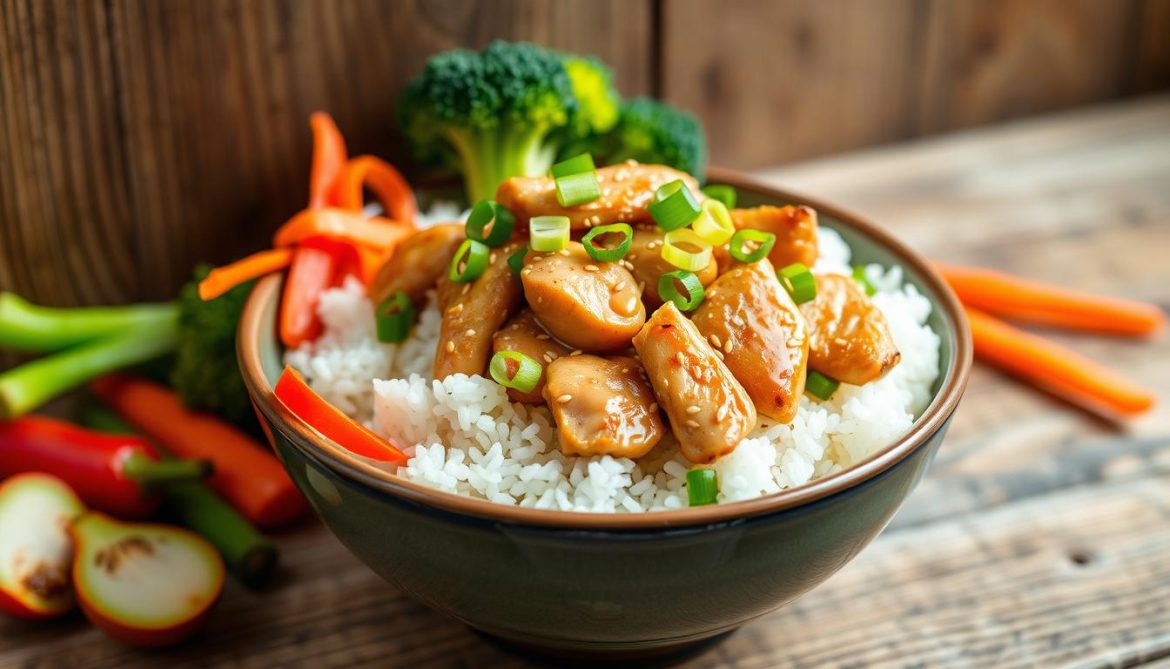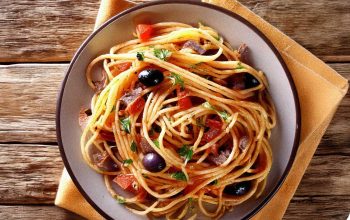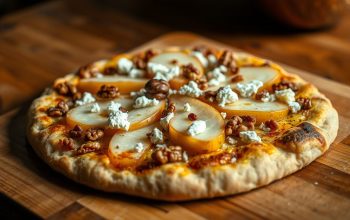Hey there, culinary adventurers! 👋 Are you ready to turn your kitchen into a flavor paradise? My Asian Ginger Chicken Bowl recipe is your new favorite meal!
This dish is more than just cooking. It’s about creating an experience. I’ve perfected it by mixing authentic Asian flavors with easy home cooking. Every bite is a mix of zesty ginger, tender chicken, and fresh veggies.
Whether you’re an experienced cook or just starting, this bowl will amaze you. We’ll cover every step, from picking the best ingredients to mastering flavors. Get ready to wow your family and improve your cooking skills! 🥢🍗
Grab your apron, sharpen those knives, and let’s start this delicious journey together!
The Essential Ingredients for Asian Ginger Chicken Bowl
Making an amazing Asian Ginger Chicken Bowl begins with picking the right ingredients. These ingredients turn a simple meal into a flavorful journey. It’s all about choosing each part carefully to create layers of taste and texture.
Fresh Aromatics and Spices
The key to a tasty Asian bowl is its fresh ingredients. These are the things that make your taste buds dance:
- Freshly minced ginger root
- Crushed garlic cloves
- Chopped green onions
- Ground white pepper
- Sesame seeds
Premium Protein Selection
For the protein, go for top-notch chicken that soaks up all the flavors. Boneless, skinless chicken breasts are great, but try thighs for a deeper taste.
“The secret to an amazing chicken bowl is using the freshest ingredients possible!” – Professional Home Cook
Base Components and Vegetables
Your base and veggies can make the dish even better. Here are some good choices:
- Jasmine or brown rice
- Crisp bell peppers
- Julienned carrots
- Snap peas
- Edamame beans
Pro tip: Mix and match your veggies for a colorful, healthy bowl that looks as good as it tastes!
Kitchen Tools and Equipment Needed
Making an amazing Asian ginger chicken bowl is easy. You don’t need a fancy kitchen. Just a few key tools will help you create a meal that will wow your taste buds!
- Sharp chef’s knife for precise vegetable and ginger cutting
- Cutting board (preferably two – one for meats, one for vegetables)
- Large skillet or wok for perfect stir-frying
- Rice cooker or medium saucepan
- Measuring cups and spoons
- Mixing bowls
- Whisk for sauce preparation
Tools for Asian bowls are simple. You probably have most of them in your kitchen already!
“The right tools make cooking not just easier, but more enjoyable!” – Culinary Enthusiast
Consider getting a non-stick skillet if you don’t have one. It ensures your chicken turns out golden and doesn’t stick.
| Tool Category | Recommended Item | Purpose |
|---|---|---|
| Cutting | 8-inch Chef’s Knife | Precise ingredient preparation |
| Cooking | Carbon Steel Wok | Authentic stir-frying technique |
| Measuring | Digital Kitchen Scale | Accurate ingredient portioning |
It’s not about the most expensive tools. Passion and creativity are what make a dish truly special!
Preparing the Perfect Ginger-Infused Sauce
Making a great ginger sauce recipe can turn a simple chicken dish into a fancy Asian chicken marinade. Let’s explore how to make a homemade stir-fry sauce that will delight your taste buds!
A great sauce comes from the right mix of ingredients. I’ve worked hard on my ginger sauce recipe. Now, I’m ready to share my top tips with you!
Sauce Base Components
- Soy sauce (low-sodium recommended)
- Fresh ginger, finely grated
- Rice vinegar
- Sesame oil
- Honey or brown sugar
Balancing Sweet and Savory Flavors
For an amazing Asian chicken marinade, you need to balance sweet and savory. Start with soy sauce for depth. Then, add freshly grated ginger for that zingy flavor. Honey adds sweetness, and rice vinegar brings a tangy note.
| Ingredient | Flavor Profile | Quantity |
|---|---|---|
| Soy Sauce | Umami, Salty | 3 tbsp |
| Fresh Ginger | Spicy, Aromatic | 2 tbsp |
| Honey | Sweet | 1 tbsp |
| Rice Vinegar | Tangy | 1 tsp |
Storage and Make-Ahead Tips
Your homemade stir-fry sauce is perfect for meal prep! Keep it in an airtight container in the fridge for up to a week. Tip: Whisk it well before using to mix any settled ingredients.
“A great sauce turns a simple meal into a culinary adventure!” – Cooking Enthusiast
Remember, the secret to a fantastic Asian chicken marinade is to experiment and find your perfect flavor mix. Don’t hesitate to tweak the ingredients to match your taste!
Marinating and Seasoning the Chicken
Mastering chicken marinade techniques is key to an amazing Asian-style marinated chicken dish. The right ginger chicken seasoning can turn simple chicken into a flavor-packed masterpiece.
Let’s explore the art of marinating chicken with some pro techniques. These will take your cooking to the next level:
- Choose the right chicken cut: Boneless, skinless chicken thighs work best for maximum flavor absorption
- Cut chicken into uniform bite-sized pieces for even marinating
- Always marinate in a non-reactive container like glass or ceramic
For the ultimate Asian-style marinated chicken, I’ve got a killer marinade recipe. It’ll make your kitchen smell amazing!
“Great marinades are all about balance and letting the flavors dance together!”
Here’s a foolproof marinade breakdown:
| Ingredient | Quantity | Purpose |
|---|---|---|
| Fresh ginger | 2 tablespoons | Adds sharp, warming flavor |
| Soy sauce | 1/4 cup | Provides umami and saltiness |
| Sesame oil | 1 tablespoon | Brings nutty depth |
| Rice vinegar | 2 tablespoons | Adds bright acidity |
Pro tip: Let your chicken marinate for at least 30 minutes, but no longer than 2 hours to prevent the meat from becoming mushy. The magic happens when you massage the marinade into every single piece, ensuring maximum flavor penetration!
Remember, great chicken marinade techniques are about patience, quality ingredients, and a little personal love sprinkled in. Your taste buds will thank you!
Cooking Techniques for Tender Asian-Style Chicken
Mastering cooking Asian chicken needs precision and passion. Let’s explore the art of making delicious chicken that will excite your taste buds!
Cooking perfect Asian chicken is more than just throwing ingredients in a pan. It’s about mastering temperature, technique, and timing.
Pan-Frying Method for Succulent Chicken
Pan-frying is key for a crispy outside and juicy inside. Here’s how to do it right:
- Use a heavy-bottomed skillet for even heat
- Pat chicken dry before cooking for crispy skin
- Choose oils with high smoke points like peanut or vegetable oil
Temperature Control Tips
Getting the right temperature is crucial for tender chicken. Here are some guidelines:
| Chicken Type | Ideal Temperature | Cooking Time |
|---|---|---|
| Chicken Breast | 375°F | 6-8 minutes per side |
| Chicken Thighs | 400°F | 8-10 minutes per side |
Achieving the Perfect Texture
For restaurant-quality chicken, temperature is everything! Use a meat thermometer to check for 165°F inside. This ensures your chicken is safe and tender.
“Cooking is love made visible” – And nothing shows love like perfectly cooked Asian chicken!
Pro tip: Let your chicken rest for 3-5 minutes after cooking. This makes every bite moist and flavorful.
Creating the Perfect Rice Base
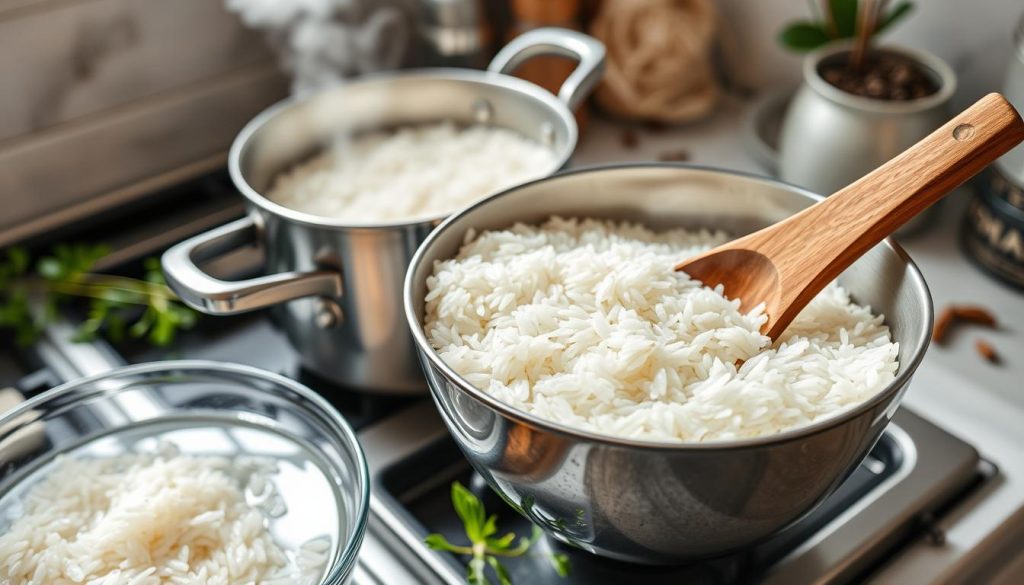
Making the perfect rice base is key for your Asian Ginger Chicken Bowl. Cooking jasmine rice needs precision to get that fluffy texture. It makes every bite magical!
Let’s explore the world of perfect rice for Asian bowls. Jasmine rice is the top choice for a delicious base. It pairs well with chicken and vegetables.
Fluffy Rice Techniques That Work Like Magic
- Rinse your rice well to remove excess starch
- Use the right water-to-rice ratio (usually 1.5 cups water per 1 cup rice)
- Let the rice rest after cooking for maximum fluffiness
“The secret to amazing rice is patience and precision!” – Professional Chef Recommendation
| Rice Type | Water Ratio | Cooking Time |
|---|---|---|
| Jasmine Rice | 1.5:1 | 15-18 minutes |
| Basmati Rice | 1.75:1 | 18-20 minutes |
Pro tip: Invest in a rice cooker for consistently perfect results every single time! The right tools can make your cooking jasmine rice experience spectacular.
Your rice should be light, separated, and have a soft yet firm texture. With these techniques, you’ll become a rice-cooking champion in no time!
Fresh Vegetable Preparation and Assembly
Turning your Asian Ginger Chicken Bowl into a stunning dish begins with vegetable prep. The right techniques can make your dish go from good to amazing! 🥬
Fresh veggies are key to a memorable stir-fry. They make your taste buds do the happy dance!
Cutting Techniques That Make a Difference
When prepping veggies for your Asian bowl, precision is crucial. Here are my top cutting tips:
- Julienne carrots for thin, elegant strips
- Diagonal cuts for crisp bell peppers
- Matchstick cuts for daikon radish
- Thin diagonal slices for cucumber
Stir-Fry Veggie Combinations
Creating the perfect veggie mix is an art. I enjoy mixing:
- Crisp snap peas
- Bright red bell peppers
- Tender baby bok choy
- Crunchy water chestnuts
Quick Pickling Magic
“A splash of vinegar can transform ordinary vegetables into extraordinary quick-pickled vegetables!” – My Kitchen Motto
Quick-pickled veggies add a burst of flavor and crunch. My favorite method is:
- Slicing veggies thinly
- Making a quick brine with rice vinegar
- Adding a pinch of sugar and salt
- Letting veggies pickle for 15-30 minutes
Pro tip: Pickled radishes and cucumbers are a must in your Asian Ginger Chicken Bowl! 🥒
Garnishing and Presentation Tips
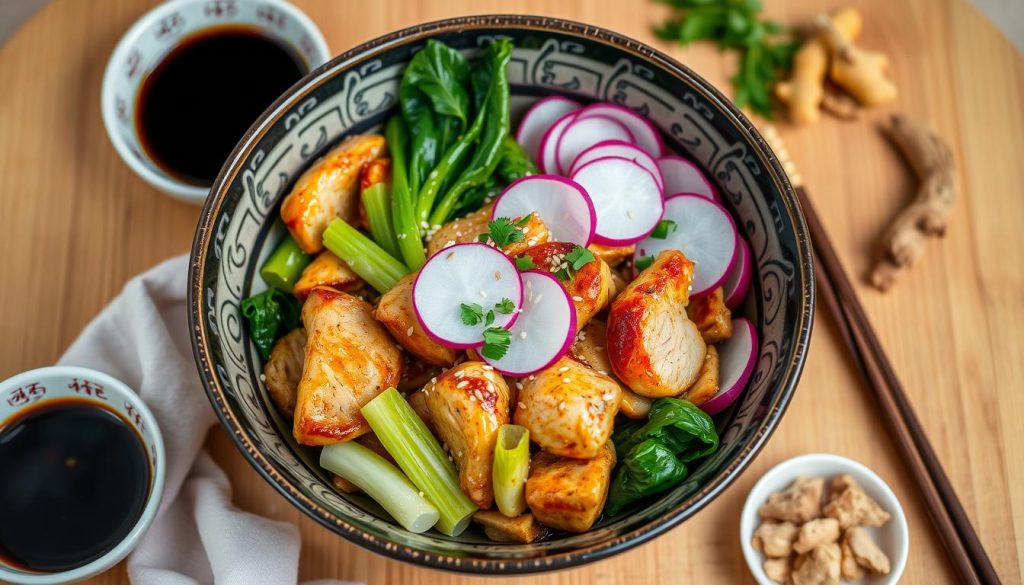
Making a stunning Asian ginger chicken bowl is more than just cooking. It’s about using food plating techniques to turn a simple meal into a feast for the eyes and taste buds.
For Asian bowl presentation, aim for visual layers and color contrast. Your dish should look as amazing as it tastes!
- Use white or neutral-colored bowls to make your ingredients pop
- Create height by stacking ingredients strategically
- Incorporate colorful garnishes for visual appeal
Garnishing tips for chicken bowls can take your dish from simple to spectacular. Here are some professional techniques:
- Sprinkle finely chopped green onions for a fresh burst of color
- Add toasted sesame seeds for texture and nutty flavor
- Drizzle a contrasting sauce in an artistic pattern
- Place a few microgreens on top for an elegant touch
Pro tip: Always garnish just before serving to maintain freshness and crisp textures!
“Cooking is an art, but presentation is the frame that makes it a masterpiece.” – Anonymous Chef
| Garnish Type | Visual Impact | Flavor Enhancement |
|---|---|---|
| Fresh Herbs | Bright Green Color | Aromatic Freshness |
| Toasted Seeds | Textural Contrast | Nutty Undertones |
| Pickled Vegetables | Vibrant Colors | Tangy Complexity |
Remember, presentation is your secret weapon. It makes meals memorable, not just tasty but also visually stunning!
Storage and Meal Prep Recommendations
Meal prep Asian bowls are a game-changer for busy home cooks! When storing your delicious ginger chicken, keep the rice and chicken separate. This helps maintain their texture. Store them in airtight containers in the fridge for up to 3-4 days.
Pro tip: keep the sauce separate to prevent soggy ingredients and preserve that incredible flavor profile.
Reheating stir-fry dishes requires a gentle touch. I recommend using a skillet or microwave with a splash of water to restore moisture. For the chicken, heat on medium-low to prevent drying out.
Vegetables stay crisp when added just before serving. If you’re planning ahead, these meal prep Asian bowls can be a lifesaver during busy weekdays!
Storing chicken and rice correctly is an art form. Glass containers work best for maintaining freshness and preventing flavor transfer. Always cool your dish completely before refrigerating to prevent bacterial growth.
When you’re ready to enjoy your leftovers, give everything a quick refresh in the pan. It’ll taste almost as good as the first serving!
Safety matters most in meal preparation. Use refrigerated leftovers within 3-4 days, and always reheat to an internal temperature of 165°F. Your taste buds and your schedule will thank you for this smart, delicious meal prep strategy!
